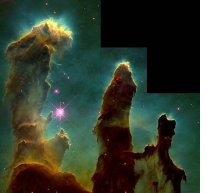

The principle of Rayleigh Scattering explains the red or orange sunsets. As the sun moves lower in the sky, its light has to travel through "more" of the atmosphere since the sun is at a much lower angle. In fact at the horizons on a level plane, the atmosphere is about 40 times more thick than it is directly overhead. Particles and molecules in the atmosphere will scatter out the shorter wavelengths (blue in the color spectrum) more easily than longer ones (red). Thus, we are left with the reddish portion of the light spectrum to see.
|
|
|
Season Starting Dates and Times
|
||
|
2024
|
||
|
Spring
|
Tuesday, Mar 19
|
10:06 PM CDT
|
|
Summer
|
Thursday, Jun 20
|
3:51 PM CDT
|
|
Autumn
|
Sunday, Sep 22
|
7:44 AM CDT
|
|
Winter
|
Saturday, Dec 21
|
3:21 AM CST |
|
2022 Major Meteor Showers
|
||||
|
Shower
|
Period of Activity |
Peak Dates
|
ZHr*
|
Comments
|
|
April 19 to April 23 |
Apr 21st and 22nd
|
20 |
The Lyrids' peak is somewhat brief. Look in the late evening of April 21st to the early morning hours of April 22nd. The best viewing will be after moonset and before dawn. The radiant for this shower is near the border of the constellations Lyra and Hercules, but it is actually better to view the Lyrids away from their radiant: They will appear longer and more spectacular from this perspective. |
|
| April 19 to May 28 |
May 4th and 5th
|
40 |
Peak time occurs for a couple of hours just before sunrise on May 5th. This shower favors the southern hemisphere and the southern latitudes of the northern hemisphere as the radiant is from near the star Eta in the constellation Aquarius. In the northern U.S. and Canada, less than 10 to 20 meteors per hour can be expected whereas the shower is quite spectacular in the southern hemisphere. |
|
| July 12 to August 23 |
Jul 28th and 29th
|
15-20
|
Peak time occurs from the late evening July 28th through the early morning of July 29th. Similar to the Eta Aquariids, this shower favors the southern hemisphere and the southern latitudes of the northern hemisphere as the radiant is near the star Delta in the constellation Aquarius. In the northern U.S. and Canada, less than 15 to 20 meteors per hour can be expected and the meteors are typically rather faint.
|
|
| July 17 to August 24 |
Aug 12th to Aug 13th
|
50-100
|
The peak of the Perseids will occur from the evening of August 12th when it gets dark, to the early morning hours of August 13th. Part of this year's peak time will occur at night for North America from 11 pm CDT on the 12th, to 4 am CDT on the 13th. The radiant is in the constellation Perseus but meteors from the Perseids are seen all over the sky. The best viewing will be on a dark sky away from the radiant. The Perseids are one of the most plentiful showers, and are also known for their fireballs. Fireballs are larger explosions of light and color that can persist longer than an average meteor streak.
|
|
| October 2 to November 7 |
Oct 20th to Oct 21st |
10-20 |
Peak viewing will be on the night of October 20-21. The radiant is north of Orion's red giant star, Betelguese, but the Orionids can occur anywhere in the sky. Orionid meteors are known for their brightness and for their speed. Fast meteors can leave glowing "trains" (incandescent bits of debris in the wake of the meteor) which last for several seconds to minutes. |
|
| November 6 to November 30 |
Nov 16th to Nov 17th |
15-20 |
The peak typically favors the hours after midnight into the early morning of November 17th. The radiant of the Leonids emanate from the constellation Leo. Leonids are also known for their fireballs and earthgrazer meteors. |
|
| December 4 to December 17 |
Dec 13th to Dec 14th
|
100-120
|
Peak viewing will be on the evening of December 13th into the morning hours of December 14th. The best viewing will occur after 9 pm CDT on December 13th, with a peak around 2 am CDT. Although not as noteworthy as the Perseids, the Geminids are actually usually the best and most consistent shower each year. The problem is being winter in North America, many times the Geminids are obscured by clouds. The Geminids' radiant is near the twin's heads in Gemini, but will occur anywhere in the sky.
|
|
| Quadrantids | December 27, 2022 to January 12, 2023 |
Jan 2nd to Jan 3rd, 2023
|
80 | Peak time is in the evening of January 2nd to early morning January 3rd. This meteor shower always favors northerly latitudes. This is because the radiant is near the handle of the Big Dipper in the northern night sky, however meteors with this shower can occur anywhere. The Quadrantids peak only lasts for a few hours, but Quadrantids are also known for their bright fireball meteors. Fireballs are larger explosions of light and color that can persist longer than an average meteor streak. |
DEFINITIONS:
*ZHr = is the maximum numbers of meteors expected per hour at Zenith (straight up in sky) and under a very dark sky. Average meteor rate can be expected to be less (much less in an urban environment.)
Radiant= A point in the sky in which meteors appear to originate.
